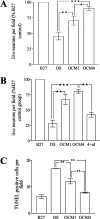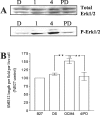Oligodendrocytes promote neuronal survival and axonal length by distinct intracellular mechanisms: a novel role for oligodendrocyte-derived glial cell line-derived neurotrophic factor
- PMID: 12832519
- PMCID: PMC6741206
- DOI: 10.1523/JNEUROSCI.23-12-04967.2003
Oligodendrocytes promote neuronal survival and axonal length by distinct intracellular mechanisms: a novel role for oligodendrocyte-derived glial cell line-derived neurotrophic factor
Abstract
Interactions of CNS cells lead to the establishment of complex neural systems. Specifically, oligodendrocytes form myelin sheaths around axons that enable rapid electrical conduction of impulses. Recent evidence has emerged that oligodendrocytes may also release trophic factors promoting neuronal survival. We therefore studied the effects of factors released from cells of the oligodendrocyte lineage on neuronal survival and also on the morphology of neurons. Neurons derived from rat embryonic cortices were cultured and exposed to media conditioned by oligodendrocyte precursor cells (OPCs) or differentiated oligodendrocytes. In line with previous studies, exposure of OPC and oligodendrocyte-conditioned media (OCM) increased survival, a phosphatidylinositol 3'-kinase (PI3kinase)/Akt-dependent phenomenon. In addition, exposure of neurons to OCM but not OPC conditioned media resulted in increased axonal length per neuron, as detected by antibodies to phosphorylated neurofilaments. OCM exposure resulted in activation of the MAPkinase/extracellular signal-regulated kinase pathway, inhibition of which significantly reduced oligodendrocyte-mediated enhancement of axonal length but, unlike PI3kinase inhibition, had no effect on neuronal survival. Furthermore, we identify glial cell line-derived neurotrophic factor (GDNF) production by differentiated oligodendrocytes and provide evidence that implicates GDNF in OCM-mediated axonal effects, independent of its effect on neuronal survival. Therefore, we have shown that factors released by OPCs and oligodendrocytes induce the activation of distinct intracellular pathways within neurons, which have different functional effects on the cell.
Figures





References
-
- Acheson A, Conover JC, Fandl JP, DeChiara TM, Russell M, Thadani A, Squinto SP, Yancopoulos GD, Lindsay RM ( 1995) A BDNF autocrine loop in adult sensory neurons prevents cell death. Nature 374: 450–453. - PubMed
-
- Atwal JK, Massie B, Miller FD, Kaplan DR ( 2000) The TrkB-Shc site signals neuronal survival and local axon growth via MAPK/Erk pathway and PI3-kinase. Neuron 27: 265–277. - PubMed
-
- Banker GA ( 1980) Trophic interactions between astroglial cells and hippocampal neurons in culture. Science 209: 809–810. - PubMed
Publication types
MeSH terms
Substances
Grants and funding
LinkOut - more resources
Full Text Sources
Other Literature Sources
